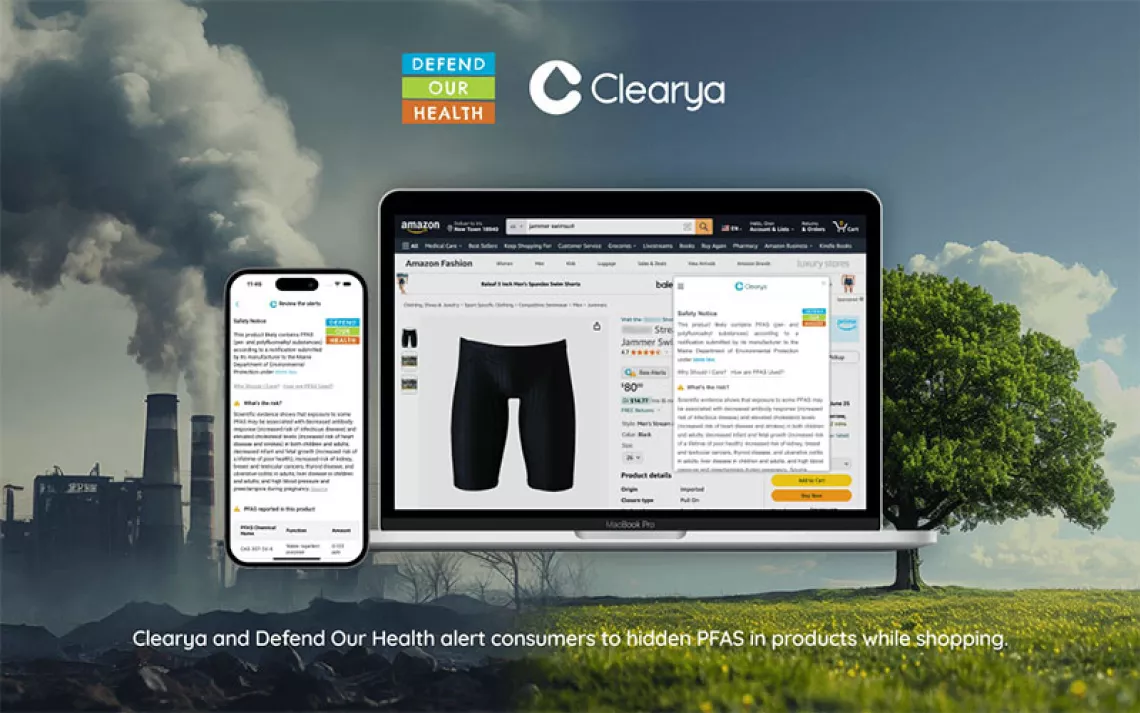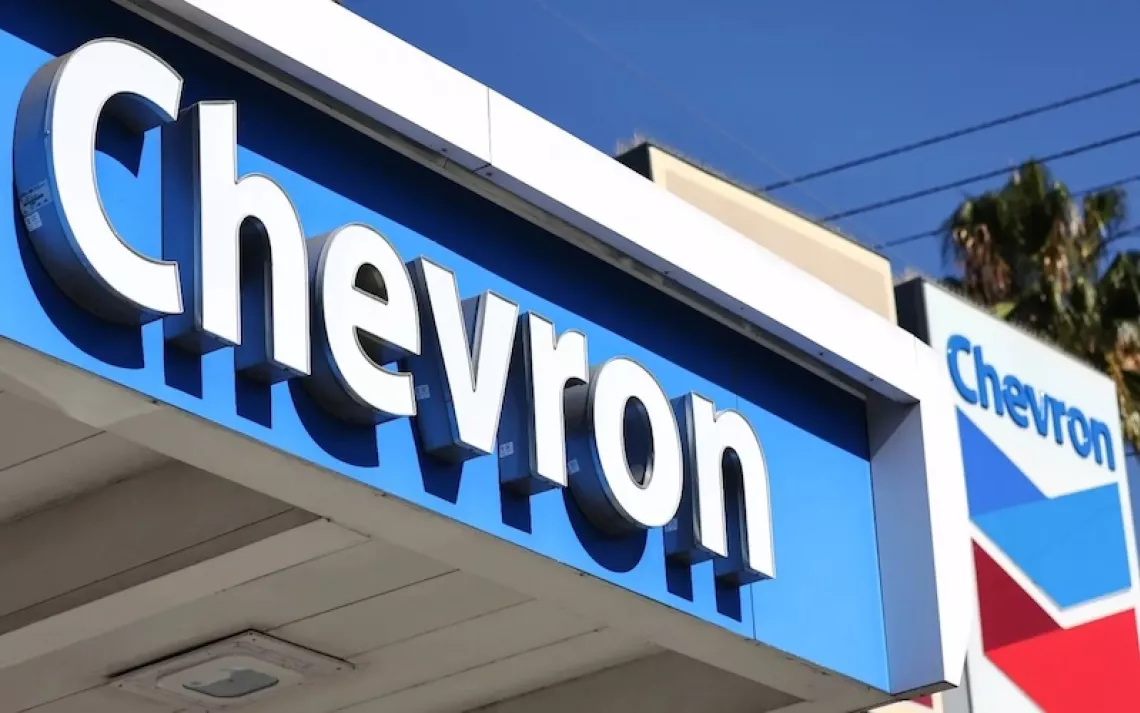All In
If we commit to it, America's electrical grid will be free of fossil fuels by the year 2030. That's only 16 years away—and it's a fix that will last forever. But first we have to kill off some zombies.
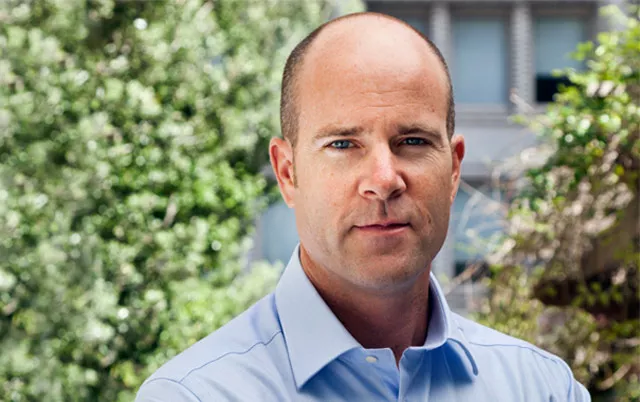
Photo by Henrik Kam
Editor's note: In a recent speech to thousands of young activists, our boss declared war on pessimism and other forces of the eco-apocalypse. We liked it so much we decided to put it in the magazine.
Lately I've been asking people, "Do you think we'll be able to cut carbon emissions enough over the next couple of decades to stop runaway climate change?" A lot of them say no. I don't agree with them, but I understand why they feel that way. When it comes to the climate, there's plenty of reason to be consumed by doubt and fear and resignation. The more you open your eyes to what's going on, the harder it is to have faith in humanity's ability to respond to this crisis. Almost every day, we hear more news from more scientists about the dark and depressing reality of climate change. And the near future is going to be even more depressing—we're going to be confronted by more and more evidence that the climate is destabilizing at a scale and a pace that we're not prepared for.
On top of that, we're seeing weekly real-world manifestations of climate disruption: fires and droughts and storms and rising seas. And when you add on Congress's basic ineptitude and dysfunction and our society's inability to have a rational discourse, it almost makes you want to head for the hills. Go buy some guns. Dig a moat around your house. Learn how to throw knives long distances and make squirrel dinners.
At the same time, we're creating a different kind of tipping point where hope about climate change is no longer merely faith-based. Because everywhere I turn, I also see that there are legitimate reasons for optimism—cautious, informed, guarded optimism—about our ability to meet this challenge.
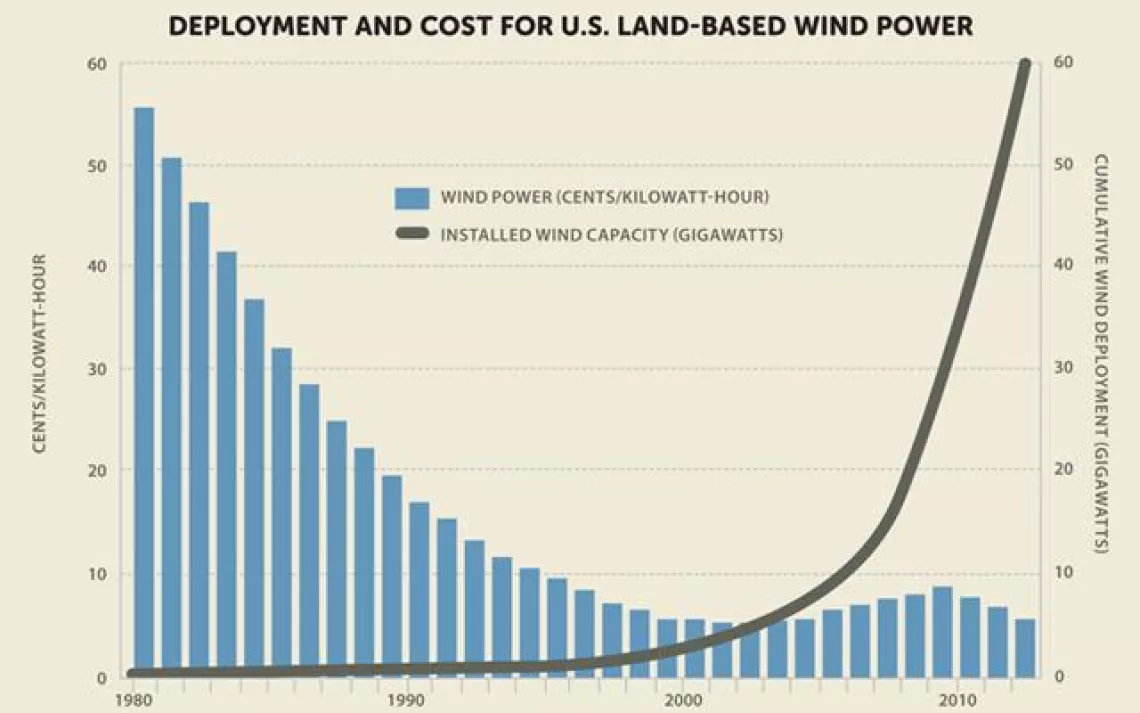
Between 1980 and 2000, the price of wind power fell tenfold. But it wasn't until 2008 that the sector began to take off, thanks to larger turbines, economies of scale in production, and increased efficiencies in turbine siting. Over the past six years, the American wind industry's electricity-generating capacity has tripled; it is now equal to that of 60 large nuclear reactors. | Source: U.S. Department of Energy
The signs are worldwide. You look overseas and see that Denmark now gets more than 25 percent of its electricity from wind; by the end of this decade, it plans to be at 50 percent. Portugal is already over 50 percent. Here in the States, Iowans now get one-fourth of their electricity from wind. California is pushing to get at least a third of its electricity from renewables by 2020, and most people think it will be closer to 40 percent. Nationwide, wind turbines have an electricity generating capacity equivalent to 60 large nuclear reactors. So this is not hippy talk anymore. This is not just a farm in Mendocino that happens to be off the grid. These are large countries and big states getting huge percentages of their power from clean energy sources.
And here's where the tipping point happens: As the clean energy marketplace expands, prices continue to plummet. When it comes to the cost of power, renewable energy sources are going head-to-head with fossil fuels. The cost of wind energy fell tenfold between 1980 and 2000, and the price of a solar panel has dropped by more than 80 percent in five years. In sunny places like California and New Mexico, the cost of solar power is already competitive with that of fossil fuels, and it's expected to be cheaper nationwide by 2020. In Colorado, executives at Xcel Energy, which delivers power to about two-thirds of the population, plan to triple the amount of solar that's coming on line. And when they talk about why, their quotes are remarkable. They're not saying, "We're doing this because of environmental or litigious reasons." They're saying, "We're doing it because it's cost-effective and economical."
All of this is just as self-reinforcing and self-replicating as climate destabilization. And it will only accelerate.
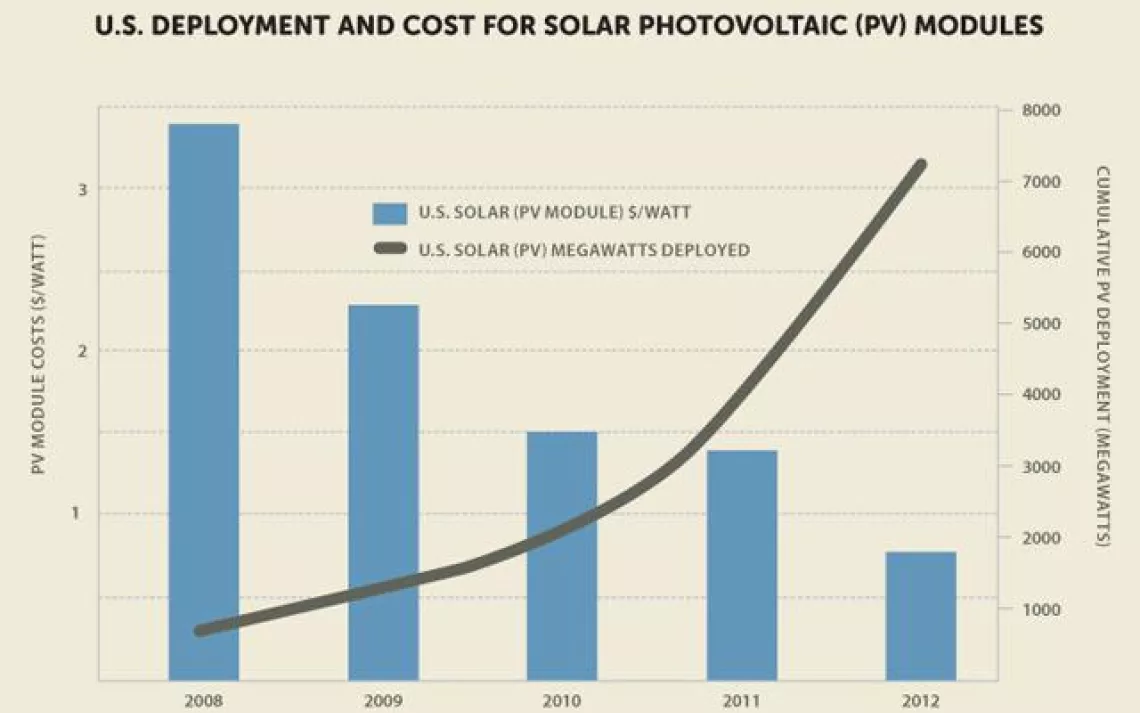
Since 2008, the generating capacity of rooftop solar panels in the United States has surged from about 735 megawatts to more than 7,200 megawatts. In sunbaked places like California and New Mexico, the unsubsidized cost of such distributed solar power—including production, installation, and financing—is already competing with that of fossil fuels, and it's on a path to be cheaper nationwide by 2020. | Source: U.S. Department of Energy
So we're in the middle of a collision between good news and bad. Clean energy growth is irrefutable. Sadly, so is the reality of extreme weather brought on by a destabilizing climate. However, most media coverage of climate and energy issues accentuates the negative, accurately reporting the tragic manifestations while also emphasizing climate denialism. This, in turn, creates a pessimism that's contagious and debilitating. It suppresses our enthusiasm, stifles our imagination, and limits our ability as individuals, as institutions, as a society, to think of big ideas—to be confident, to be ambitious, to be passionate about solutions. We need an end to this kind of pessimism.
And we need to be very clear about what it is that we're fighting for: a 100 percent clean energy economy. Today, the Sierra Club needs to do for clean energy solutions what John Muir did for wilderness exploration and getting people into the outdoors. We need to bring our passion and our muscle and our intellect to bear and accelerate the clean energy revolution; drive oil, gas, and coal companies off our priceless public lands; and secure a carbon-free power sector by 2030.
Sixteen years from now, every time you turn on a light or power up your computer, every bit of that electricity should come from carbon-free sources. Soon after that, solar and wind will displace nuclear as well, at which point we'll be getting 100 percent of our electricity from renewable sources. We should also be able to cut transportation oil use in half by 2030, and then cut it in half again a decade later. To be fair, this is the outside edge of what most engineers and energy experts believe is achievable, but it's also at the minimum edge of what scientists say is absolutely necessary to stabilize our planet.
So let's go all in. Let's act as voters, as citizens, as consumers, as investors, as neighbors, to push for a world powered by clean energy. Let's integrate this ambition into all aspects of our lives. Let's make sure that the solar panels on homes and churches don't just power an interconnected local grid but also power our cars and buses. Let's make sure that, as consumers and investors, we support those companies that are moving toward a 100 percent clean energy vision and punish those companies that are holding us back. And through crowdfunding and other sources, let's put our money to work to accelerate the pace at which clean energy displaces fossil fuels.
Other generations have taken on great challenges. They've defeated fascism in Europe. They've put a man on the moon. But we have an opportunity to accomplish something even bigger. We could be the generation that finds a way for society to power itself sustainably and cleanly, forever. Let me repeat that: forever. We have an opportunity to create a prosperous society that forevermore gets all of its power from sources that are safe and secure and sustainable. What an amazing accomplishment, and it's actually within our grasp.
We can do this within the next generation. My one-year-old daughter will grow up during the era when we finally get rid of fuels that make us sick. By the time she's 19, she'll say, "You used to poison your water just to turn on your computer? You used to give people asthma and risk their lives just to make sure that your lightbulbs got lit?" It'll seem nuts to her. Just as it seems nuts now that there was ever a time when people who were different colors couldn't sit down and have lunch together, or when women weren't allowed to vote.
And all of this can happen with the technology that we have right now, in our lifetime, while we're here.
David Brower once said that in environmentalism there are no permanent victories; there are only permanent defeats. He was probably talking about Glen Canyon Dam, but his point had wider implications, and he was mostly correct. When you convert an ancient forest into two-by-fours and toilet paper, that's a defeat that lasts forever—or at least for a really, really long time.
Brower is one of my heroes, but his idea of permanent defeat doesn't apply to clean energy. Because when the growth of cheap solar electricity shuts down a coal-fired power plant, it's the victory that's permanent. Once we put fossil fuels in our rearview mirror, we are never going back. I'm never going to take the solar panels off my house. I'm never going to say, "I want a car that pollutes more."
And if Brower were alive, I'd tell him that once we genuinely get to a place where all of our energy is coming from renewable sources, we are going to not only displace oil, gas, coal, and nuclear but also take down those hydroelectric dams. Even Glen Canyon Dam will come down. In our lifetime.
But first we have to get over the fear that we're not up to the challenge. Sometimes we environmentalists embrace our underdog role too much. For too long, we've attached our identity to being outmatched by our opponents. We almost revel in the Koch brothers and ExxonMobil and this greedy shadow that they cast over America. People talk about the coal companies and the gas companies as though they're invincible, but they're not. They're dangerous, they're reckless, and they're often criminal, but their influence is overblown. They're like zombies—they don't know they're already dead.
For every Koch brother, we've got a Tom Steyer or a Jeremy Grantham or a Michael Bloomberg—billionaires who stand beside us. For every dollar earned by Exxon, we have a consumer who cares about clean energy—conservatives, liberals, people in red states and blue states and rural areas and urban areas. We're more powerful than we think, we're more numerous than we think, and we're more successful than we think. We are already winning.
There's no question that the 21st-century economy will be dominated by clean energy. Every day, we take another bite out of the market share of both the coal and the gas industries. We have them on the defensive. They have no place in a society that has embraced clean energy. It's inevitable. The only question is: How quickly will we get there?
This article was adapted from a keynote address that Michael Brune gave in October at the Power Shift conference in Pittsburgh. This article has been corrected.
 The Magazine of The Sierra Club
The Magazine of The Sierra Club


